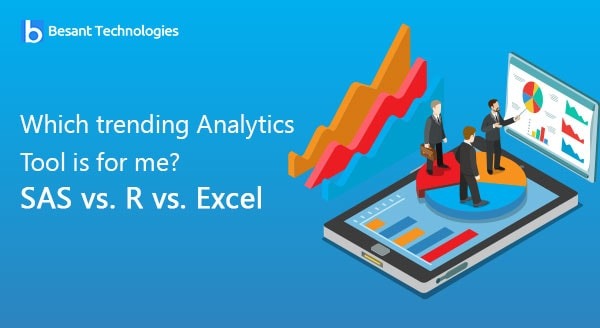
Which trending Analytics Tool is for me? SAS vs. R vs. Excel
Classical statistical analysis met computer programming and they had a baby—big data analysis. This baby has grown up since its first steps with Google and eBay and has become a powerful giant. Today, big data analysis has a permanent seat at the decision-making table of almost all major corporations. More than half of businesses that do not have big data analysts—and there are many around the world—are expected to hire big data analysts in the next few years. This means growth rates in the demand for big data analysts—and salaries—that are staggering. Big data analyst demand growth is expected to be in the teens in the next few years, while their salaries already fit squarely in the six digits.
The primary tool for big data analysis Training is software. It needs software that collects, organizes, and manages information, helping turn enormous amounts of data into meaningful insights that can be used for making decisions. Anyone who wants to do big data analysis needs to know which programs are the most effective. The one who masters the right business intelligence tools will rule the market. Partisans are already up in arms over their favourite software, but it is clear that the choice depends on:
- User’s experience in programming
- User’s experience in statistics
If you have the time, learn everything with Gangboard for online Training and Besant Technologies for classroom training. If you don’t, the following can help you get an idea of the strengths and weaknesses of SAS, R, and Excel.
Excel-The Humble Butler
Excel is probably the most easily available and immediately understandable tool for big data analysis. This humble software has from the beginning been the layman’s data analysis tool, even before anyone knew what data analysis was. It is, however, supremely simple, or, to put it bluntly, it is not even in the same league as SAS or R. However, it does have a few simple yet key capabilities that can make a presentation look a lot more sophisticated.
Excel makes graphs, sorts data in columns, filters information, and constructs tables and allows you to pivot them to make information easier to understand. Excel also allows the user to input hypothetical values to test their outcomes, aids in finding solutions to decision problems and it offers the Analysis ToolPak. Besides this, it also comes with an add-on pack of data analysis tools for statistical, engineering, and financial data analysis. It is not a bad tool for something that has been available to computer users since the very beginning.
SAS-The Plush Cadillac
SAS is expensive but relatively user-friendly, and most companies who use statistical analysis today use SAS. It has 35% market share which is twice that of the nearest competitor, according to IDC (International Data Corporation), and it has been around for almost five decades. SAS is optimal for working with immense databases; carrying out heavy calculations and routines that fit within the standard, classical procedures that have been developed over the years.
It also has good documentation feature to help the user set up appropriate analysis. However, its graphics have been criticised as clumsy and confusing, and it is relatively inflexible, slow to incorporate newer methods of analysis or to carry out unusual procedures. For all that, R is the best choice.
R-The Genie
R is basically a programming language that combines standard programming capabilities with statistical analysis. The result is a tool that can basically do anything that any software could possibly do but it takes a lot of training and knowledge to be able to handle effectively. R is very flexible and can be used to carry out unusual or non-standard procedures and is consequently quick to adopt new procedures and innovations.
At the same time, it has libraries for almost everything that has been tried with the language. It also has excellent graphics with a wide range of possibilities. However, it takes some training to be able to use it to its full potential. Perhaps its biggest drawback is that it is newer than SAS and is therefore not as frequently used by companies. But this is changing. Research indicates that as the field of bid data analysis evolves and companies try to carry out newer procedures, R is quickly gaining on SAS. Plus, the fact that R is free, open-source, and has available active discussion boards greatly helps its growing popularity.
Which one fits the bill for you?
There is no way to say which business intelligence tool is universally, objectively the best one, because each has strengths that the others do not. This truth is proven in the marketplace by the fact that all three continue to survive. The choice of one over another ultimately depends on the user’s time and amount of training. May options are available to take any of these traning like R Progrmming Online Training and class room training.
A user who will be running standard procedures on large data sets and who does not have time for learning a new language would most likely be better off with SAS. A user who wants flexibility and the ability to twist data around like a contortionist and who has the time to put into learning a new language, would likely thrive with R. And then there is, of course, Excel, which is easy to learn and can carry out simple procedures that popular culture associates with data analysis today, like graphs, tables, and charts.


